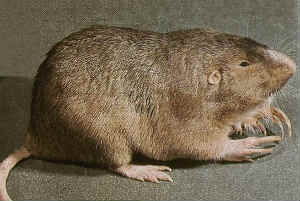Pocket Gopher Hybrids
Family Geomyidae
EUGENE M. MCCARTHY, PHD GENETICS, ΦΒΚ
Pocket Gopher Hybrids - Reported crosses:
 Plains Pocket Gopher
Plains Pocket GopherGeomys bursarius
Note: Several hybridizing chromosomal races of Geomys attwateri exist in eastern Texas. Williams and Cameron 1991.
Geomys attwateri [Attwater’s Pocket Gopher]
× Geomys breviceps [Baird’s Pocket Gopher] ENHR(Texas). HPF(♂&♀). Pregnant F1 hybrids were found, but many F2 fetuses are inviable. Parapatric contact zone in southeastern Texas (see Schmidly 2004). Tucker and Schmidly (1981) demonstrated the existence of a hybrid zone along Road 50 in Burleson Co. (between Somerville and Brenham). See also: Honeycutt and Schmidly 1979). Hybrids resemble G. attwateri. Williams and Cameron 1991.
× Geomys personatus [Texas Pocket Gopher] NHR. CON: Texas. Williams 1982; Williams and Genoways 1981
Geomys breviceps [Baird’s Pocket Gopher]
See also: Geomys attwateri.
× Geomys bursarius [Plains Pocket Gopher] NHR(central U.S.). These gophers were recently split. Contact zone in northern Texas and southern Oklahoma. Hart concluded that gene flow is occurring, but that more investigation is needed. Cothran and Zimmerman 1985; Hart 1978 (p. 12); Sulentich et al. 1991; Tucker and Schmidly 1981 (p. 267).
Note: Two populations, bursarius and lutescens, treated as races of Geomys bursarius, have a narrow hybrid zone in Kansas and Nebraska. Heaney and Timm (1985) say hybrids occur in soils that are intermediate between that occupied by bursarius (silt loam) and that occupied by lutescens (sand). They also say that two different types of lice infest bursarius and lutescens. In animals of both types lice were present in large numbers. However, most gophers identified as hybrids had no lice. Due to hybridization, these taxa are usually lumped (but were treated as separate species by Heaney and Timm). They are morphologically distinct. Burns et al. 1985; Heaney 1979; Heaney and Timm 1983, 1985; Hendricksen 1973; Sudman et al. 1987; Timm et al. 1982.
Geomys bursarius [Plains Pocket Gopher]
See also: Geomys breviceps.
× Gallus gallus (♀) [Domestic Chicken] See the separate article “A Gopher-chicken hybrid?.”
× Geomys knoxjonesi (♀) [Knox Jones’ Gopher] ENHR(southwestern U.S.). HPF(♀♀). These gophers were until recently treated as conspecific. Similar in habits and appearance, but different in karyotype, they hybridize along a narrow contact zone in southeastern New Mexico and western Texas. They were split because fertility is reduced in their hybrids. Hybrids occur in soils transitional between the hard loamy soil favored by bursarius and the sandy soil associated with knoxjonesi. Bradley et al. 1991; Davis 1986; Hopton and Cameron 2001; Jones et al. 1995; Pembleton and Baker 1978; Schmidly 2004 (p. 340).
Geomys knoxjonesi [Knox Jones’ Gopher] See: Geomys bursarius.
Geomys personatus [Texas Pocket Gopher] See: Geomys attwateri.
Note: Two populations (actuosus, ruidosae), treated as races of Thomomys bottae, have a hybrid zone in central New Mexico (southwestern U.S.). These populations differ markedly in karyotype, but it can be inferred that hybrids are partially fertile (since the zone is composed mostly of later-generation hybrids). Patton et al. 1979
Thomomys bottae [Botta’s Pocket Gopher]
× Thomomys townsendii (♂) [Townsend’s Pocket Gopher] ENHR(w U.S.) Hybrid zone is in northeastern California. HPF. All examined hybrids bore a T. bottae mtDNA haplotype. Weight of T. bottae females averages ~1/3 that of T. townsendii males, which suggests they actively sought townsendii males since their burrows would have been too small for townsendii males to enter. Hybridization occurs along narrow (~1 km wide) zones adjacent to Honey Lake (Lassen Co.). In the region near the lake, populations assigned to T. bottae are genetically more similar to T. townsendii than to populations in southern and central California assigned to T. bottae Patton and Smith 1989). Thus bottae approaches townsendii morphologically in the regions of contact, a clear indication of extensive hybridization. Patton and Smith 1989, 1993, 1994; Patton et al. 1984; Smith 1998; Thaeler 1968; Verts and Carraway 2003.
× Thomomys umbrinus [Southern Pocket Gopher] ENHR(southeastern Arizona). HPF(♀♀). Hybrids of both sexes occur. In a study at Sycamore Canyon (Patagonia Mountains, Santa Cruz Co.), Hoffmeister (1969) found that 38.6% of specimens collected in a 2.5-mile wide contact zone were hybrid. Most recognized hybrids were first generation, but later-generation hybrids are always more difficult to recognize. An abrupt shift in coloration occurs across the zone. Due to their extensive hybridization, these gophers have sometimes been lumped. Hoffmeister 1969, 1986 (p. 240); Patton 1973; Patton and Dingman 1968; Patton et al. 1973.
Thomomys talpoides [Northern Pocket Gopher] Hybridization occurs between chromosomal races, some of which, according to Thaeler, ought to be treated as separate species. Nevo et al. 1974; Nevo and Bar-El 1976; Thaeler 1974.
Thomomys townsendii [Townsend’s Pocket Gopher]
See also: Thomomys bottae.
× Thomomys umbrinus [Southern Pocket Gopher] NHR. DRS. Thaeler 1968.
By the same author: Handbook of Avian Hybrids of the World, Oxford University Press (2006).